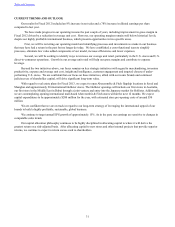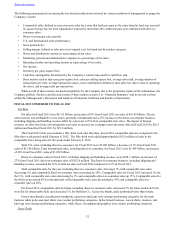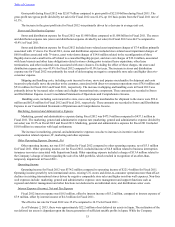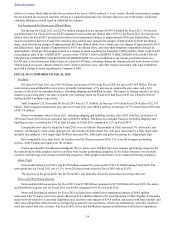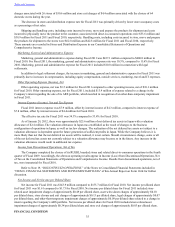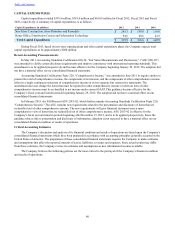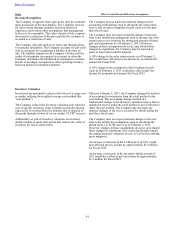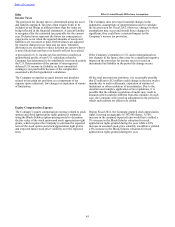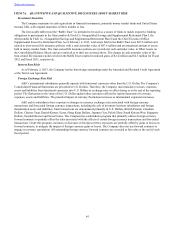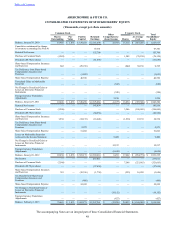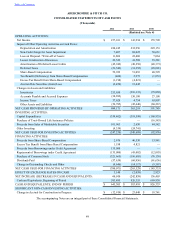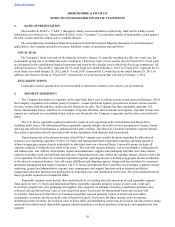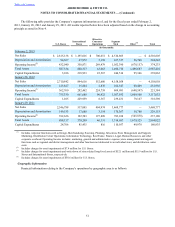Abercrombie & Fitch 2013 Annual Report Download - page 41
Download and view the complete annual report
Please find page 41 of the 2013 Abercrombie & Fitch annual report below. You can navigate through the pages in the report by either clicking on the pages listed below, or by using the keyword search tool below to find specific information within the annual report.
41
Policy Effect if Actual Results Differ from Assumptions
Revenue Recognition
The Company recognizes retail sales at the time the customer
takes possession of the merchandise. The Company reserves
for sales returns through estimates based on historical
experience and various other assumptions that management
believes to be reasonable. The value of point of sale coupons
that result in a reduction of the price paid by the customer is
recorded as a reduction of sales.
The Company sells gift cards in its stores and through direct-
to-consumer operations. The Company accounts for gift cards
sold to customers by recognizing a liability at the time of
sale. The liability remains on the Company’s books until the
earlier of redemption (recognized as revenue) or when the
Company determines the likelihood of redemption is remote,
known as breakage (recognized as other operating income),
based on historical redemption patterns.
The Company has not made any material changes in the
accounting methodology used to determine the sales return
reserve and revenue recognition for gift cards over the past
three fiscal years.
The Company does not expect material changes in the near
term to the underlying assumptions used to measure the sales
return reserve or to measure the timing and amount of future
gift card redemptions as of February 2, 2013. However,
changes in these assumptions do occur, and, should those
changes be significant, the Company may be exposed to
gains or losses that could be material.
A 10% change in the sales return reserve as of February 2,
2013 would have affected pre-tax income by an immaterial
amount for Fiscal 2012.
A 10% change in the assumption of the breakage for gift
cards as of February 2, 2013 would have affected pre-tax
income by an immaterial amount for Fiscal 2012.
Inventory Valuation
Inventories are principally valued at the lower of average cost
or market utilizing the weighted average cost method (the
"cost method").
The Company reduces the inventory valuation only when the
cost of specific inventory items on hand exceeds the amount
expected to be realized from the ultimate sale or disposal of
the goods through a lower of cost or market ("LCM") reserve.
Additionally, as part of inventory valuation, an inventory
shrink estimate is made each period that reduces the value of
inventory for lost or stolen items.
Effective February 2, 2013, the Company changed its method
of accounting for inventories from the retail method to the
cost method. This accounting change resulted in a
fundamental change in the inventory valuation reserve from a
markdown reserve under the retail method to an LCM reserve
under the cost method. The Company has not made any
material changes to the way it accounts for shrink during the
past three fiscal years.
The Company does not expect material changes in the near
term to the underlying assumptions used to determine the
shrink reserve or LCM reserve as of February 2, 2013.
However, changes in these assumptions do occur, and, should
those changes be significant, they could significantly impact
the ending inventory valuation at cost, as well as the resulting
gross margin(s).
An increase or decrease in the LCM reserve of 10% would
have affected pre-tax income by approximately $1.0 million
for Fiscal 2012.
An increase or decrease in the inventory shrink accrual of
10% would have affected pre-tax income by approximately
$1.2 million for Fiscal 2012.
Table of Contents


